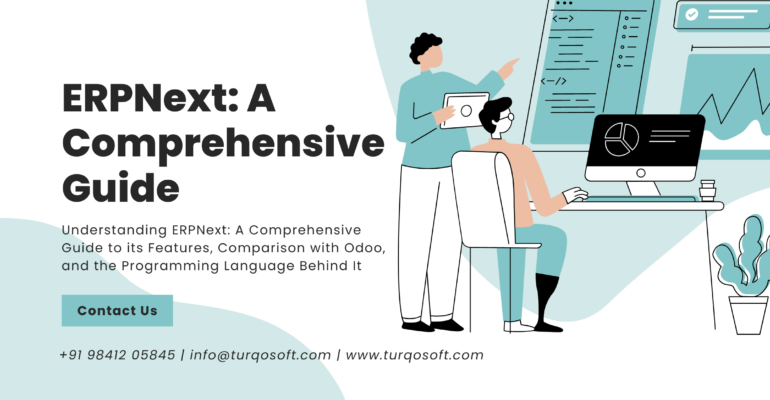ERPNext: A Comprehensive Guide

ERPNext: A Comprehensive Guide
Organizations of all sizes are constantly seeking ways to streamline their operations and enhance productivity. Enterprise Resource Planning (ERP) systems have emerged as powerful solutions to address these challenges. One such popular open-source ERP system is ERPNext.
Understanding ERPNext: A Comprehensive Guide to its Features, Comparison with Odoo, and the Programming Language Behind It
In this article, we will explore what ERPNext is used for, delve into its notable features, compare it with Odoo, and discuss the programming language behind it.

ERPNext is a comprehensive, open-source ERP software designed to streamline and integrate various business processes, ranging from accounting and inventory management to human resources and project management. It is built on modern web technologies and offers a modular structure that can be customized to suit the specific needs of different industries and organizations.

Here are some of the key features of ERPNext:
Accounting and Finance Management
- General Ledger: Manage accounts, financial statements, and budgets.
- Accounts Receivable/Payable: Track and manage customer and supplier transactions.
- Bank and Cash Management: Record and reconcile banking transactions.
- Fixed Assets: Track and manage fixed assets and depreciation.
Inventory and Warehouse Management
- Stock Management: Monitor inventory levels, track stock movements, and manage stock valuation.
- Purchasing: Streamline procurement processes and manage supplier relationships.
- Sales and Distribution: Track sales orders, manage pricing, and generate invoices.
- Manufacturing: Plan and manage production processes, bill of materials, and work orders.
Customer Relationship Management
- Lead and Opportunity Management: Capture and track leads, and convert them into opportunities.
- Customer Support: Manage support tickets, track communication history, and provide efficient customer service.
- Marketing Campaigns: Create and manage marketing campaigns, track responses, and measure effectiveness.
Human Resources (HR) and Payroll
- Employee Management: Maintain employee records, manage leaves, and track attendance.
- Recruitment: Streamline the hiring process, manage job postings, and applicant tracking.
- Payroll Management: Calculate employee salaries, generate payslips, and handle statutory compliance.
ERPNext vs. Odoo
ERPNext and Odoo are both popular open-source ERP solutions. While they share similarities, there are notable differences between them. Here are a few key points of comparison:

User Interface and User Experience
- ERPNext: Known for its simplicity and intuitive design, offering a user-friendly experience.
- Odoo: Features a modern and customizable interface with an extensive range of modules.
Customization and Flexibility
- ERPNext: Provides a highly customizable framework, allowing users to tailor the system to their unique requirements.
- Odoo: Offers a wide range of pre-built modules and a user-friendly customization interface.
Community and Ecosystem
- ERPNext: Boasts a strong and growing community, contributing to regular updates and improvements.
- Odoo: Possesses a larger community and ecosystem, resulting in a wider range of third-party apps and integrations.
Pricing and Licensing
- ERPNext: Primarily open-source with a subscription model for additional support and features.
- Odoo: Follows a freemium model, offering a community edition (open-source) and enterprise editions with additional features and support.
ERPNext Programming Language
ERPNext is built using the Frappe framework, which is itself developed using the Python programming language.

Python is a popular, high-level, and versatile programming language known for its simplicity, readability, and extensive libraries. It enables rapid development and promotes a clean, modular code structure.
Frappe, the web framework underlying ERPNext, leverages Python’s strength to create a robust and scalable ERP system. It follows the Model-View-Controller (MVC) architectural pattern, allowing developers to separate the business logic, presentation, and data layers.
Python’s rich ecosystem of libraries and frameworks further enhances the development process for ERPNext. Some of the notable libraries used in ERPNext development include:
Flask
A lightweight web framework used for handling HTTP requests, routing, and creating RESTful APIs.
Jinja2
A templating engine that enables the dynamic generation of HTML pages and email templates.
SQLAlchemy
A powerful Object-Relational Mapping (ORM) library that simplifies database interactions and supports multiple database backends.
Celery
A distributed task queue system is used for handling asynchronous tasks and background processing.
The Frappe framework, built on top of Python, abstracts the complexities of web development and provides a high-level API for creating and managing ERPNext modules. It includes features such as form rendering, data validation, database interactions, and user authentication.
The framework also supports internationalization, making it easier to translate ERPNext into multiple languages.
With Python as its programming language, ERPNext benefits from a large and active community of Python developers. This ensures continuous improvement, bug fixes, and the availability of third-party integrations and extensions. Additionally, Python’s extensive documentation and online resources make it easier for developers to learn and contribute to ERPNext’s development.
Conclusion
ERPNext is a versatile open-source ERP system that offers a wide range of features to streamline business operations. From accounting and inventory management to CRM and HR, ERPNext covers various aspects of enterprise management.
When compared to Odoo, ERPNext stands out with its user-friendly interface and high level of customization.
The Frappe framework, built using Python, provides a solid foundation for ERPNext’s development, ensuring scalability, modularity, and a vibrant developer community.
As organizations continue to seek efficient and integrated solutions, ERPNext proves to be a compelling choice for businesses of all sizes. Its open-source nature, extensive feature set, and flexible architecture make it a powerful tool for optimizing processes, increasing productivity, and achieving growth in today’s competitive market.
If you are considering implementing ERPNext and unlocking the full potential of your organization to stay ahead in today’s competitive business landscape do drop us a message and we will be happy to guide you. Alternatively, you can also connect with us through email at info@15.206.92.4 or call us at +91 9841205845. Also, you can follow us on LinkedIn, Facebook, Twitter, or Instagram for interesting updates.


